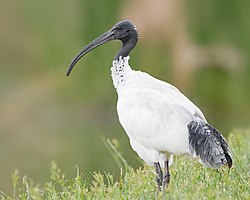Australian white ibis
| Australian white ibis | |
|---|---|
 |
|
| Scientific classification | |
| Kingdom: | Animalia |
| Phylum: | Chordata |
| Class: | Aves |
| Order: | Pelecaniformes |
| Family: | Threskiornithidae |
| Subfamily: | Threskionithinae |
| Genus: | Threskiornis |
| Species: | T. moluccus |
| Binomial name | |
|
Threskiornis moluccus Cuvier, 1829 |
|
| Subspecies | |
|
|
| Synonyms | |
|
Threskiornis molucca |
|
Threskiornis molucca
The Australian white ibis (Threskiornis moluccus) is a wading bird of the ibis family, Threskiornithidae. It is widespread across much of Australia. It has a predominantly white plumage with a bare, black head, long downcurved bill and black legs. Its sister species is the sacred ibis.
Historically rare in urban areas, the Australian white ibis has immigrated to urban areas of the east coast in increasing numbers since the late 1970s; it is now commonly seen in Wollongong, Sydney, Melbourne, the Gold Coast, Brisbane and Townsville. In recent years the bird has also become increasing common in Perth, Western Australia and surrounding towns in south-western Australia. Populations have disappeared from natural breeding areas such as the Macquarie Marshes in north-western New South Wales. Management plans have been introduced to control problematic urban populations in Sydney.
It was initially described by Georges Cuvier in 1829 as Ibis molucca. It is considered part of a superspecies complex with the sacred ibis (T. aethiopicus) of Africa, and the black-headed ibis (T. melanocephalus) of Asia. Its status in the complex has vacillated over the years. Many older guidebooks referred to the bird as a species T. molucca, until a comprehensive review of plumage patterns by Holyoak in 1970. Holyoak noted the three species' similarities and that the Australian taxon resembled T. aethiopicus in adult plumage and T. melanocephalus in juvenile plumage. He proposed they all be considered part of a single species T. aethiopicus. This was generally accepted by the scientific community until Lowe and Richards's assessment of plumage in 1991. They again recommended the recognition of molucca at species level. This was followed by chromosome study which highlighted each of the three species having a different karyotype. The Australian white ibis has been considered a full species by most authorities since then.
...
Wikipedia

